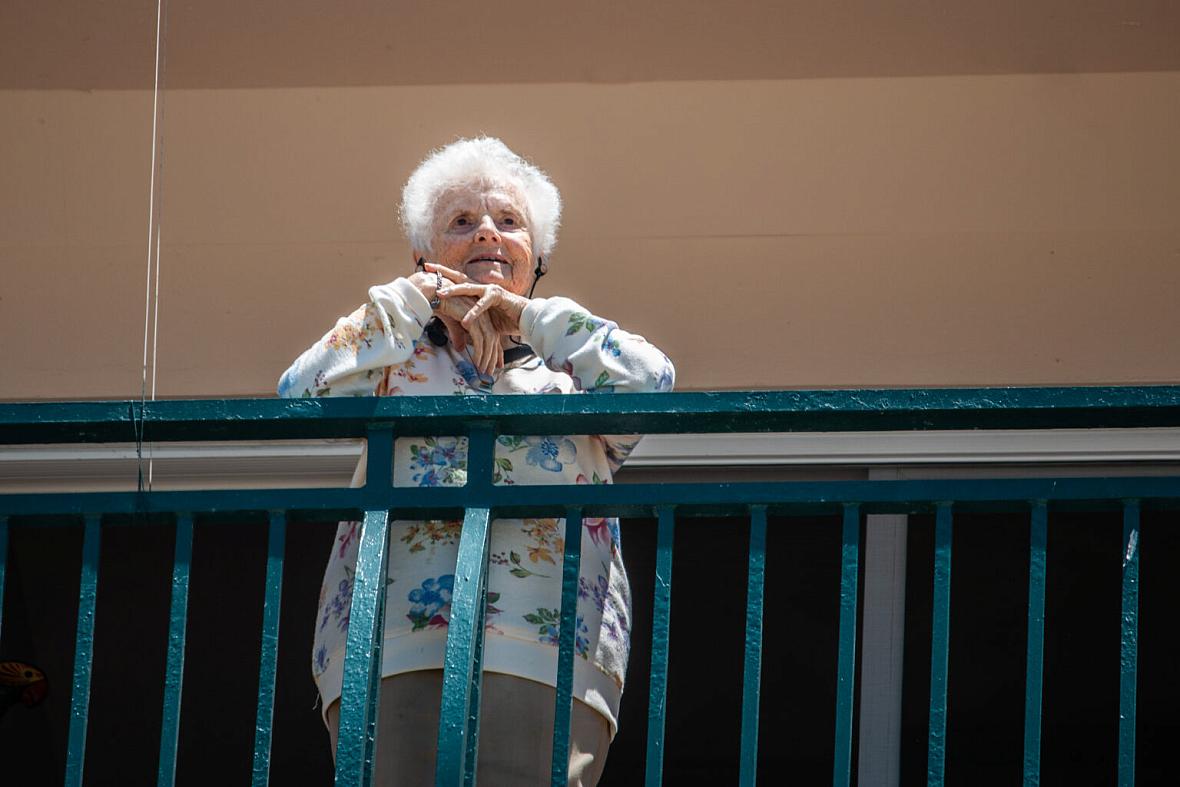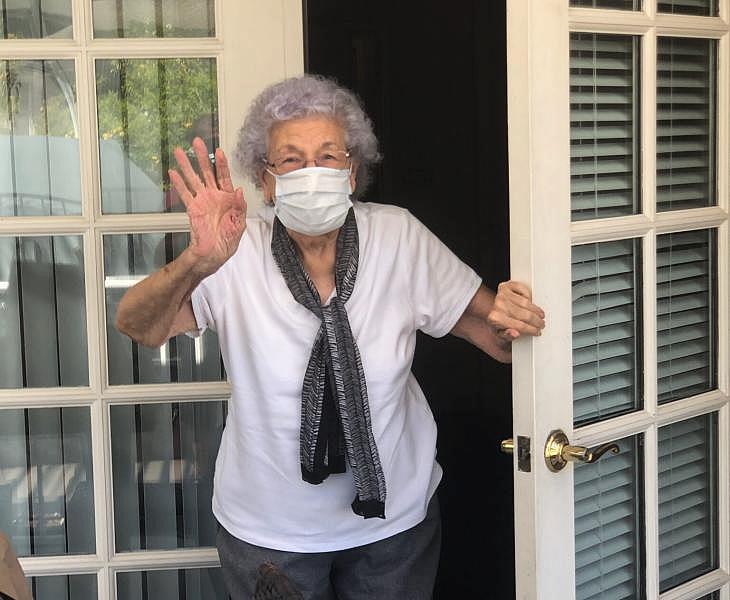No Visitors Leading to Despair and Isolation in Senior Care Homes
This story was produced as part of a larger project led by Jared Whitlock, a participant in the 2019 Impact Fund, that reports on San Diego's assisted living industry.
Other stories in this series include:
Doctors Say They’re Not Getting Vital Coronavirus Info About Senior Facilities
La Mesa Assisted Living Facility Has State’s Second-Highest Death Toll
Widespread COVID-19 Testing Still Elusive in Senior Homes
COVID-19 Lawsuit Against La Jolla Facility Could Signal More Fights to Come
COVID-19 Testing Plans Leave Out Assisted Living Facilities
Confirmed Nursing Home Complaints Plummet During Pandemic
COVID-19 Exposes Lack of Medical Staff in Assisted Living Facilities

Natasha Josefowitz looks beyond her balcony at the White Sands Retirement Community in La Jolla
Photo by Adriana Heldiz
When Jan Thompson drops off care packages to her 95-year-old mom, about 8 feet separate them. It’s the closest they’ve been in a while.
Her mom lives at Monte Vista Village in Lemon Grove. In March, the assisted and independent living facility — along with other long-term care homes — shuttered to visitors with the aim of keeping out COVID-19.
Some facilities are staying in lockdown, despite recent guidance permitting outdoor or window visits at a minimum. A crop of families, doctors and advocacy groups have advocated for an expansion in visitation, citing isolation that can trigger a decline in health.
Facilities are cautious following a rise in cases — and a grim statistic: Nationally, 42 percent of coronavirus-linked deaths have occurred in long-term care facilities.
Every week, Thompson drives to Monte Vista Village, relaying cherry-filled packages to a caregiver, while her mom stands outside her door and waves. Thompson isn’t allowed to get too close or linger. She tries to foster engagement in other ways: FaceTime, phone calls and lists with what they’ll do and see when the pandemic ends.
When her mom isn’t reading or watching TV, she goes on walker-assisted strolls, circling the same pavement day after day.
Thompson said she’s grateful for no COVID-19 cases in the facility, and for the staff’s quality care. But she senses her mom withdrawing after almost five months without much in-person interaction.
Jan Thompson’s mother, Ruth Bailey / Photo courtesy of Jan Thompson
“My mom never complains. She’s of that generation, and she’s a Texan,” Thompson said. “But she’s now reflecting in our conversations, ‘What is there to live for?’”
Except for end-of-life situations, visitors largely haven’t stepped foot in facilities during the pandemic.
But under state rules issued in June, indoor visits in nursing homes are limited to one person at a time, provided there are no new cases in a facility for 14 days, no rebound in cases in the larger community, and adequate testing and staffing. Facilities that can’t check all these boxes are supposed to provide socially distanced outdoor visits — or window and car visits.
Similar guidance exists for assisted living facilities, which provide non-medical care.
Susan Burwin, the executive director of Monte Vista Village, said in an email the facility is reviewing “current conditions and updated visitation guidelines from the applicable authorities and evaluating if any changes can be made to our current visitation policy.”
Watchdog groups say senior care homes have been too slow to resume visits, including outdoor ones.
“Not every facility has outdoor areas. Not all residents are able to be moved outside. But also, crucially, it’s an inconvenience for facility operators. It requires a certain amount of staff and logistical planning,” said Michael Dark, an attorney with California Advocates for Nursing Home Reform. The pandemic exacerbated long-running staffing issues in nursing homes, he added.
Deborah Pacyna, a spokeswoman for the California Association of Healthcare Facilities, said county health departments can prevent outdoor visits at care homes when deemed too risky.
In response, a San Diego county spokeswoman said the county isn’t telling senior facilities to stop outdoor visits, as long as they follow state guidance.
♦♦♦
A self-described joker, Natasha Josefowitz said there isn’t as much to laugh about these days.
The 93-year-old author resides in White Sands La Jolla, an independent living facility that barred visitors in March.
Before the pandemic, her watch logged 10,000 steps a day, reflecting beach strolls and a busy social calendar. Now, she walks back and forth from her apartment to the dining hall, hoping 40 percent of her normal step count is enough to stave off health issues.
Instead of dinner with friends, she eats alone in her room. “I watch the sunset. But I have no one to share it with,” said Josefowitz, who was a business professor for nearly 30 years.
For Josefowitz, Zoom feels like a poor substitute for socializing. Citing a lack of in-person contact, she constantly battles lethargy.
Still, she finds brightspots. Josefowitz highlighted her relatively privileged circumstances, namely attentive staff and zero coronavirus cases in the beachfront building.
In a recent newspaper column, Josefowitz wrote about the pandemic affording free time to tackle procrastinated tasks. She was moved to share her experience after unearthing mementos in her apartment, including a 1964 letter from a man who thanked her for arranging the adoption of his newborn son, leading her to virtually track down the adoptee, now in his mid-50s.
“When the pandemic is over, he wants to visit me,” Josefowitz wrote. But White Sands La Jolla doesn’t allow visitors and it’s unclear when it might loosen up.
“White Sands La Jolla is currently not open to visitors outside of essential health care providers and vendors. Our priority remains focused on the health and safety of our residents and team members,” said spokesman Edie Burge.
With limited visits occurring, local initiatives and websites like Love for the Elderly help well-wishers write letters to those in senior care homes.
Researchers are studying the pandemic’s impact on senior mental health. In preliminary research findings, 41 percent of seniors in primarily community settings in San Francisco reported worsening loneliness, said Dr. Carla Perissinotto, in testimony to a U.S. Senate hearing in June.
“Like many, I became concerned about the downstream effects that we would see during this COVID-19 pandemic,” Perissinotto said.
Perissinotto and colleagues at the University of California, San Francisco, in a 2012 study found loneliness in seniors — regardless of whether they lived with others — was linked to a greater risk of death.
Visitors do more than boost spirits. In some cases, they provide critical care, like feeding loved ones or checking for bedsores. Yet in California, these family members generally haven’t been permitted in facilities during the pandemic.
Minnesota, by contrast, lets in certain family members, clad in personal protective gear, for up to three hours a day to monitor care and lessen loneliness. A Facebook group called Essential Family Caregivers wants to codify national access.
“I want to see people unify, regardless of differences, to win a humane balance for these otherwise voiceless souls,” said Maitely Weismann, who formed the group. She said her mother, who has dementia and traumatic brain injury, doesn’t do well with outdoor visits at a long-term care facility.
“It’s just not going to be the same as being there more casually and helping her out a little, while she decides when and how to express herself as I tidy up, help her dress, etc.,” Weismann said.
Dr. Aram Harijan, who cares for patients in nursing homes across San Diego, said that without family visits some residents stop eating, potentially leading to starvation. That heart-wrenching outcome, he added, seems to be less common than a month or two ago for reasons unclear, though it’s still alarming.
Nursing homes are “still pretty much locked down,” he said.
Some say certain visitation rules are too permissive. Officials with the California Department of Social Services — which regulates assisted living facilities — recently stated that residents can visit their families at home, and then return to the facility.
Cyndy Minnery, a consultant for the senior care industry, said the policy could lead to asymptomatic residents coming back to a facility and unwittingly spreading COVID-19. She recommends that facilities pursue other types of visitation options, at least for now.
“Who knows what they could be exposed to during a family outing?” asked Minnery, who wasn’t aware of any senior facilities sanctioning these at-home visits, likely for liability reasons.
An agency spokesman said a returning resident should receive a temperature check and be asked about COVID-19 symptoms and exposure to anyone with the virus.
“The decision to require isolation or quarantine is dependent on if the individual was exposed during the outing or has any symptoms,” said spokesman Scott Murray.
♦♦♦
Margie Schroeder said her 82-year-old mother — who lives in La Vida Real — sunk into a deep depression after months without face-to-face contact. It got so bad that recently her mom didn’t want to take family phone calls.
“She cries a lot at night. It’s the nighttime that gets to her,” said Schroeder.
Last week, after a Voice of San Diego inquiry, La Vida Real OK’d scheduled family courtyard and balcony visits. It came after a July 2 letter to families and residents, in which the facility said it would continue to bar visitors, after an employee contracted COVID-19.
Since the pandemic began, 21 staffers and 13 residents at La Vida Real contracted COVID-19, according to state data. Of these residents, fewer than 11 died. The state doesn’t disclose precise death counts upon 10 or fewer deaths in a senior home.
There are no active COVID-19 cases at the facility, per the state data.
“We are balancing the necessary precautionary measures such as intensive screening procedures, proactive testing, detailed contact tracing and exacting safety standards for cleaning and disinfecting with safe and appropriate opportunities for residents to connect,” said the facility in an emailed statement.
Schroeder said while thrilled about the new visitation policy, she ultimately wants to remove her mom from the facility for family care. But the plan is part of a legal dispute with another family member who disagrees.
For now, Schroeder said her mom, upon hearing that family would soon visit, “cried her eyes out” with relief.
Jared Whitlock reported this story with support from the 2019 Impact Fund, a program of the USC Annenberg Center for Health Journalism.
[This article was originally published by Voice of San Diego.]

